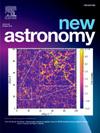Prediction of solar cycles 26 and 27 based on LSTM-FCN
IF 2.1
4区 物理与天体物理
Q2 ASTRONOMY & ASTROPHYSICS
引用次数: 0
Abstract
Predicting solar activity changes is crucial for Earth’s climate, communication systems, and aerospace technology. This study employs the Long Short-Term Memory Fully Convolutional Network (LSTM-FCN) deep learning method to predict the amplitudes and peak times of Solar Cycles (SCs) 26 and 27 for both the entire solar disk and the northern and southern hemispheres. The experimental data comprises the monthly mean total Sunspot Number (SSN) data and the monthly mean northern and southern Hemispheric Sunspot Number (HSN) data, provided by the World Data Center — Sunspot Index and Long-term Solar Observations (WDC-SILSO). The experimental process tested the Input–Output Window Ratio (IOWR) from 4:1 to 14:1, and the results indicate that when the IOWR is 10:1, the normalized Relative RMSE (RRMSE) is minimized at 0.078. According to the prediction, SC 26 is expected to peak in June 2034 with an amplitude of 194.4, and SC 27 is expected to peak in July 2045 with an amplitude of 244.2. It was also found that SC 26 and SC 27 have northern and southern hemisphere asymmetry. This study demonstrates the potential application of the LSTM-FCN deep learning method in forecasting SCs, providing a new tool and approach for solar physics research.
基于LSTM-FCN的太阳周期26和27的预报
预测太阳活动变化对地球气候、通信系统和航空航天技术至关重要。本研究采用长短期记忆全卷积网络(LSTM-FCN)深度学习方法,对整个太阳盘和南北半球的太阳周期(SCs) 26和27的振幅和峰值时间进行了预测。实验数据由世界数据中心-太阳黑子指数和长期太阳观测(WDC-SILSO)提供的月平均总太阳黑子数(SSN)和月平均南北半球太阳黑子数(HSN)数据组成。实验过程对输入输出窗口比(IOWR)在4:1 ~ 14:1范围内进行了测试,结果表明,当IOWR为10:1时,归一化相对RMSE (RRMSE)最小,为0.078。根据预测,SC 26预计在2034年6月达到峰值,振幅为194.4,SC 27预计在2045年7月达到峰值,振幅为244.2。还发现sc26和sc27具有南北半球不对称性。本研究证明了LSTM-FCN深度学习方法在太阳太阳质量预报中的潜在应用,为太阳物理研究提供了新的工具和途径。
本文章由计算机程序翻译,如有差异,请以英文原文为准。
求助全文
约1分钟内获得全文
求助全文
来源期刊

New Astronomy
地学天文-天文与天体物理
CiteScore
4.00
自引率
10.00%
发文量
109
审稿时长
13.6 weeks
期刊介绍:
New Astronomy publishes articles in all fields of astronomy and astrophysics, with a particular focus on computational astronomy: mathematical and astronomy techniques and methodology, simulations, modelling and numerical results and computational techniques in instrumentation.
New Astronomy includes full length research articles and review articles. The journal covers solar, stellar, galactic and extragalactic astronomy and astrophysics. It reports on original research in all wavelength bands, ranging from radio to gamma-ray.
 求助内容:
求助内容: 应助结果提醒方式:
应助结果提醒方式:


